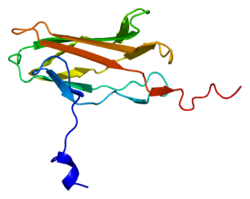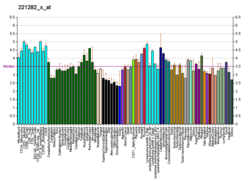RUNX2
Protein-coding gene in humans From Wikipedia, the free encyclopedia
Runt-related transcription factor 2 (RUNX2) also known as core-binding factor subunit alpha-1 (CBF-alpha-1) is a protein that in humans is encoded by the RUNX2 gene. RUNX2 is a key transcription factor associated with osteoblast differentiation.

It has also been suggested that Runx2 plays a cell proliferation regulatory role in cell cycle entry and exit in osteoblasts, as well as endothelial cells. Runx2 suppresses pre-osteoblast proliferation by affecting cell cycle progression in the G1 phase.[6] In osteoblasts, the levels of Runx2 is highest in G1 phase and is lowest in S, G2, and M.[5] The comprehensive cell cycle regulatory mechanisms that Runx2 may play are still unknown, although it is generally accepted that the varying activity and levels of Runx2 throughout the cell cycle contribute to cell cycle entry and exit, as well as cell cycle progression. These functions are especially important when discussing bone cancer, particularly osteosarcoma development, that can be attributed to aberrant cell proliferation control.
Function
Summarize
Perspective
Osteoblast differentiation
This protein is a member of the RUNX family of transcription factors and has a Runt DNA-binding domain. It is essential for osteoblastic differentiation and skeletal morphogenesis. It acts as a scaffold for nucleic acids and regulatory factors involved in skeletal gene expression. The protein can bind DNA both as a monomer or, with more affinity, as a subunit of a heterodimeric complex. Transcript variants of the gene that encode different protein isoforms result from the use of alternate promoters as well as alternate splicing.
The cellular dynamics of Runx2 protein are also important for proper osteoblast differentiation. Runx2 protein is detected in preosteoblasts and the expression is upregulated in immature osteoblasts and downregulated in mature osteoblasts. It is the first transcription factor required for determination of osteoblast commitment, followed by Sp7 and Wnt-signaling. Runx2 is responsible for inducing the differentiation of multipotent mesenchymal cells into immature osteoblasts, as well as activating expression of several key downstream proteins that maintain osteoblast differentiation and bone matrix genes.
Knock-out of the DNA-binding activity results in inhibition of osteoblastic differentiation. Because of this, Runx2 is often referred to as the master regulator of bone.[7]
Cell cycle regulation
In addition to being the master regulator of osteoblast differentiation, Runx2 has also been shown to play several roles in cell cycle regulation. This is due, in part, to the fact that Runx2 interacts with many cellular proliferation genes on a transcription level, such as c-Myb and C/EBP,[5] as well as p53/[7] These functions are critical for osteoblast proliferation and maintenance. This is often controlled via oscillating levels of Runx2 within throughout cell cycle due to regulated degradation and transcriptional activity.
Oscillating levels of Runx2 within the cell contribute to cell cycle dynamics. In the MC3T3-E1 osteoblast cell line, Runx2 levels are a maximum during G1 and a minimum during G2, S, and mitosis.[5] In addition, the oscillations in Runx2 contribute to G1-related anti-proliferative function.[8] It has also been proposed that decreasing levels of Runx2 leads to cell cycle exit for proliferating and differentiating osteoblasts, and that Runx2 plays a role in mediating the final stages of osteoblast via this mechanism.[9] Current research posits that the levels of Runx2 serve various functions.
In addition, Runx2 has been shown to interact with several kinases that contribute to facilitate cell-cycle dependent dynamics via direct protein phosphorylation. Furthermore, Runx2 controls the gene expression of cyclin D2, D3, and the CDK inhibitor p21(cip1) in hematopoietic cells. It has been shown that on a molecular level, Runx associates with the cdc2 partner cyclin B1 during mitosis.[10] The phosphorylation state of Runx2 also mediates its DNA-binding activity. The Runx2 DNA-binding activity is correlated with cellular proliferation, which suggests Runx2 phosphorylation may also be related to Runx2-mediated cellular proliferation and cell cycle control. To support this, it has been noted that Runx is phosphorylated at Ser451 by cdc2 kinase, which facilitates cell cycle progression through the regulation of G2 and M phases.[10]

Pathology
Summarize
Perspective
Cleidocranial dysplasia
Mutations in Runx2 are associated with the disease Cleidocranial dysostosis. One study proposes that this phenotype arises partly due to the Runx2 dosage insufficiencies. Because Runx2 promotes exit from the cell cycle, insufficient amounts of Runx2 are related to increased proliferation of osteoblasts observed in patients with cleidocranial disostosis.[11]
Osteosarcoma
Variants of Runx2 have been associated with the osteosarcoma phenotype.[5] Current research suggests that this is partly due to the role of Runx2 in mitigating the cell cycle.[6] Runx2 plays a role as a tumor suppressor of osteoblasts by halting cell cycle progression at G1.[5] Compared to normal osteoblast cell line MC3T3-E1, the oscillations of Runx2 in osteosarcoma ROS and SaOS cell lines are aberrant when compared to the oscillations of Runx2 levels in normal osteoblasts, suggesting that deregulation of Runx2 levels may contribute to abnormal cell proliferation by an inability to escape the cell cycle. Molecularly, It has been proposed that proteasome inhibition by MG132 can stabilize Runx2 protein levels in late G1 and S in MC3T3 cells, but not in osteosarcoma cells which consequently leads to a cancerous phenotype.[6][5]
Regulation and co-factors
Due to its role as a master transcription factor of osteoblast differentiation, the regulation of Runx2 is intricately connected to other processes within the cell.
Twist, Msh homeobox 2 (Msx2), and promyeloctic leukemia zinc-finger protein (PLZF) act upstream of Runx2. Osterix (Osx) acts downstream of Runx2 and serves as a marker for normal osteoblast differentiation. Zinc finger protein 521 (ZFP521) and activating transcription factor 4 (ATF4) are cofactors of Runx2.[12] Binding of the transcriptional coregulator, WWTR1 (TAZ) to Runx2 promotes transcription.
Furthermore, in proliferating chondrocytes, Runx2 is inhibited by CyclinD1/CDK4 as part of the cell cycle.[13]
Interactions
RUNX2 has been shown to interact with:
- AR[14]
- ER-α[15]
- C-Fos,[16][17]
- C-jun,[16][17]
- HDAC3,[18]
- MYST4,[19]
- SMAD1[20][21]
- SMAD3,[20][21] and
- STUB1.[22]
and
- SMOC1.[23]
miR-133 and CyclinD1/CDK4 directly inhibits Runx2.[24][13]
See also
References
Further reading
External links
Wikiwand - on
Seamless Wikipedia browsing. On steroids.







